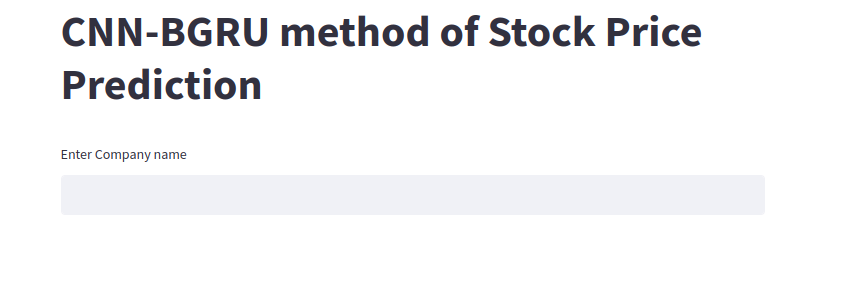
Stock Price Prediction with CNN-BGRU Model
In this post we are writing code to forecast the stock price of companies listed in NEPSE (Nepal Stock Exchange) according to CNN-BGRU method mentioned in this paper.
The user is asked to enter the stock symbol of the desired company and the future. Here future means the duration of forecast in days. For example, future =0 means the model will forecast the stock price of tomorrow.
The application will train the model when the user pushes the train button. The app will also show graph which compares the actual and predicted values. The app will also save the trained model.
User can then get the forecast with a press of a button.
Links
Create a virtual environment
mkdir Nepse_CNN_BGRU
cd Nepse_CNN_BGRU
python3 -m venv venv
source venv/bin/activateCreating a git repository
gh repo create
#Then walk through
#For more instructionsBasic installation
#install streamlit
pip3 install streamlit
#library for web scrapping
pip3 install requests_html bs4
#install scikit-learn
pip3 install -U scikit-learn
#install tensorflow
python3 -m pip install tensorflow
#install scipy
python3 -m pip install scipyCreate few necessary file
touch main.py interpolate.py rnn_models.py scrapper.py process.pyScrapper.py
This library has function price_history, which takes in stock symbol and start date as the argument and returns the closing price of that stock since the ‘start_date’.
from bs4 import BeautifulSoup
from requests_html import HTMLSession
#using regex to format string
import re
import pandas as pd
from datetime import datetime
import numpy as np
def price_history(company_name,Start_date):
# initialize an HTTP session
session = HTMLSession()
url = "https://www.nepalipaisa.com/Modules/CompanyProfile/webservices/CompanyService.asmx/GetCompanyPriceHistory"
max_limit = 5000
# Start_date = "2011-12-15"
#End_date = "2020-12-15"
End_date = datetime.today().strftime('%Y-%m-%d')
data = {"StockSymbol": company_name, "FromDate": Start_date, "ToDate": End_date, "Offset": 1, "Limit": max_limit}
res = session.post(url, data=data)
result = res.text
#removing comma
result = result.replace(',', '')
# removing <anything> between < and >
a = re.sub("[\<].*?[\>]"," ", result)
# this will return float and int in string
d = re.findall("(\d+(?:\.\d+)?)", a)
print(d[-20])
real_max = int(d[-20])
close_price = []
start = 5
for i in range(real_max):
close_price.append(float(d[start]))
start = start + 20
dates = []
start = 14
for i in range(real_max):
temp = d[start]+ "-"+d[start+1]+"-"+d[start+2]
dates.append(temp)
start = start + 20
#Puting scrapped closed price with date in dataframe
lst_col = ["Date","Close"]
df = pd.DataFrame(columns = lst_col)
df['Date'] = dates
df['Close'] = close_price
#Putting oldest data at the start of dataframe
df = df.iloc[::-1]
#setting date as index
df = df.set_index('Date')
df = df.dropna()
#replacing zero with previous data
#df = df['Close'].replace(to_replace=0, method='ffill')
df = df['Close'].mask(df['Close'] == 0).ffill(downcast='infer')
#print(type(df))
df = df.to_frame()
#print(type(df))
#df.plot(figsize=(16, 9))
return df
process.py
This takes the stock price of the company in the form of panda dataframe along with future and lookback period and returns numpy array suitable for tensorflow model along with mean and standard deviation of data.
import numpy as np
import pandas as pd
from sklearn import preprocessing
def make_frame(input_frame, scaled_frame,rows,columns):
for j in range(rows):
count = 0
for i in range(0+j,columns+j):
input_frame[j][count] = scaled_frame[i][0]
count = count + 1
return input_frame
def data_for_model(company_df,Look_back_period,future):
company_df = company_df.fillna(method='ffill')
numpy_array = company_df.values
close_array = numpy_array
entries_total = close_array.shape[0]
mean_std_array = np.array([close_array.mean(),close_array.std()])
mean_std_scaler = preprocessing.StandardScaler()
close_scaled = mean_std_scaler.fit_transform(close_array)
rows = Look_back_period
columns = entries_total-(rows+future)
company_input = np.zeros(shape=(rows,columns))
company_input = make_frame(company_input,close_scaled,rows,columns)
company_input = company_input.T
company_output = np.zeros(shape=(columns,1))
for i in range(rows,(columns+rows)):
company_output[i-rows][0] = close_scaled[i+future][0]
#combining all arrays
features = 1
company_input_3d = np.zeros(shape=(columns,rows,features))
company_input_3d[:,:,0] = company_input
return_list = []
return_list.append(mean_std_array)
return_list.append(company_input_3d)
return_list.append(company_output)
return return_listrnn_models.py
This library contains various functions:
- Model_CNN_BGRU : The tensorflow model itself
- model_prediction : For prediction
- MAPE: Calculate MAPE between actual and predicted prices
- final_prediction: Prediction of future
import pandas as pd
import numpy as np
import tensorflow as tf
from tensorflow.keras.models import Sequential
from tensorflow.keras.layers import Dense
from tensorflow.keras.layers import LSTM, Bidirectional, GRU, Conv1D,Conv2D,MaxPooling1D
def Model_CNN_BGRU(X,Y,Look_back_period):
model = Sequential()
model.add(Conv1D(100, (3), activation='relu', padding='same', input_shape=(Look_back_period,1)))
model.add(MaxPooling1D(pool_size=2,strides=1, padding='valid'))
model.add(Bidirectional(GRU(50)))
model.add(Dense(1))
model.compile(loss='mean_squared_error',optimizer='adam',metrics = ['accuracy'])
print(X.shape)
model.fit(X,Y,epochs=100,batch_size=64,verbose=0)
model_cnn_bgru = model
return model_cnn_bgru
def model_prediction(data,model,company_df,Look_back_period,future):
L = Look_back_period
f = future
a = data
mean_std = a[0]
mean = mean_std[0]
std = mean_std[1]
# 5 is no of features
ran = company_df.shape[0] - (L+f)
company_df = company_df.reset_index()
#Dataframe to record
column_names = ["Date", "Actual","Prediction"]
record = pd.DataFrame(columns = column_names)
#print(record)
for i in range(ran):
count = i+L
tail =company_df[i:count]
#print(tail)
# setting date as index
tail = tail.set_index('Date')
numpy_array = tail.values
predict_input = np.zeros(shape=(1,L,1))
for i in range(L):
predict_input[:,i] = numpy_array[i]
predict_scaled = (predict_input-mean)/(std)
print("Shape of predict scaled")
print(predict_scaled.shape)
#load model
prediction = model.predict(predict_scaled)
predict_final = (prediction*(std)) + mean
count = count + f
date = company_df['Date'][count]
actual = company_df['Close'][count]
list_predict = [date,actual,predict_final[0][0]]
series_predict = pd.Series(list_predict, index = record.columns)
record = record.append(series_predict, ignore_index=True)
#converting to datatime format
record['Date'] = pd.to_datetime(record['Date'], infer_datetime_format=True)
print(type(record['Date'][0]))
return record
def MAPE(record):
num = record.shape[0]
record['error'] = abs((record['Actual']-record['Prediction'])/record['Actual'])
sum2 = record['error'].sum()
MAPE = sum2/num
return MAPE
def final_prediction(company_df,lookback,data,model):
mean_std = data[0]
mean = mean_std[0]
std = mean_std[1]
last_data = company_df.tail(lookback)
last_data = last_data.values
predict_scaled = (last_data-mean)/(std)
predict_scaled = predict_scaled.reshape((1,lookback,1))
prediction = model.predict(predict_scaled)
predict_final = (prediction*(std)) + mean
return predict_finalinterpolate.py
According to this paper the lookback period suitable for different types of prediction are as follows:
- Short term (Tomorrow): suggested lookback period = 5 days
- Mid term (After 15 days) : suggested lookback period = 50 days
- Long term (After 30 days) : suggested lookback period = 100 days
For other futures i.e value between 0-15 and 15-30, the lookback period is calculated using cubic-spline interpolation with the help of scipy library.
from scipy.interpolate import CubicSpline
import numpy as np
def find_lookback(future):
x = [0, 15, 30]
y = [5, 50, 100]
# use bc_type = 'natural' adds the constraints as we described above
f = CubicSpline(x, y, bc_type='natural')
x_new = future
y_new = int(f(x_new))
print(y_new)
return y_newmain.py
This is the main file containing the code for streamlit
import streamlit as st
import pandas as pd
from tensorflow.keras.models import load_model
#Importing my own libraries
from scrapper import price_history
from process import data_for_model
from rnn_models import Model_CNN_BGRU
from rnn_models import model_prediction
from rnn_models import final_prediction
from rnn_models import MAPE
from interpolate import find_lookback
def main():
#setting starting date on 1st jan 2018
Start_date = "2018-10-01"
#setting default value of lookback period and future
lookbackperiod = 5
future = 0
#Any empty dataframe
company_df = pd.DataFrame()
#The title
st.title('CNN-BGRU method of Stock Price Prediction')
#Asking using to enter the symbol listed in NEPSE
company_name = st.text_input('Enter Company name')
if(company_name != ""):
#Asking user to enter the future
future = st.text_input('Enter future')
if(type(future) == str and future != ""):
future = int(future)
#Setting the lookback period for different type of futures
if(future == 0):
lookbackperiod = 5
elif(future == 15):
lookbackperiod = 50
elif (future == 30):
lookbackperiod = 100
#using cubic spline interpolation to calculate lookback period
elif (type(future) == int):
lookbackperiod = find_lookback(future)
else:
future = 0
try:
#calling function to get price history
company_df = price_history(company_name,Start_date)
except:
print("An exception occurred")
#Printing the basics
st.subheader('Head of Data')
st.dataframe(company_df.head())
st.subheader('Tail of Data')
st.dataframe(company_df.tail())
st.write("Length of data")
st.write(len(company_df))
st.write("Length of lookback period")
st.write(lookbackperiod)
#converting the dataframe to data ready for tensorflow model
data = data_for_model(company_df,lookbackperiod,future)
X = data[1]
Y = data[2]
#Press this button to train the model
#Along with training, we also compare the predicted and actual price
#save the model
model_name = 'model_cnn_bgru_'+company_name+"_"+str(future)+".h5"
if st.button('Train and save Model'):
st.write('Training')
model_CNN_BGRU = Model_CNN_BGRU(X,Y,lookbackperiod)
st.write('Saving')
model_CNN_BGRU.save(model_name)
st.write('Predicting ')
record = model_prediction(data,model_CNN_BGRU,company_df,lookbackperiod,future)
record = record.set_index('Date')
st.write(record)
st.line_chart(record)
error = MAPE(record)
st.write('Calculating MAPE')
error = error*100
st.write(error)
#When this button is pressed our model will finally predict the stock price in required future
if st.button("Predict for future"):
#model_name = 'model_cnn_bgru_'+company_name+"_"+str(future)+".h5"
model = load_model(model_name)
prediction = final_prediction(company_df,lookbackperiod,data,model)
prediction = "This model predicts that the stock price of " + company_name + " after "+str(future+1)+" days "+"is "+str(prediction[0][0])
st.write(prediction)
if __name__ == '__main__':
main()Run the streamlit
streamlit run main.pyOutput
Landing Page

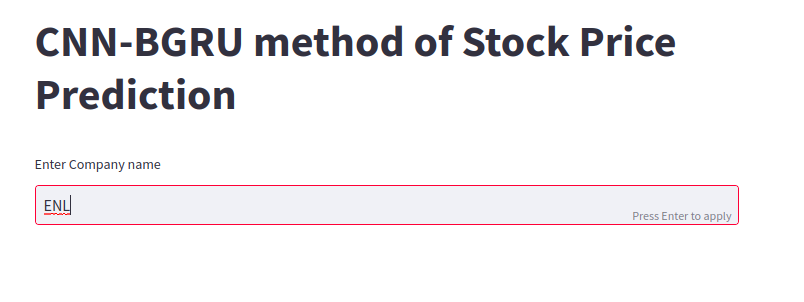
After entering the stock symbol
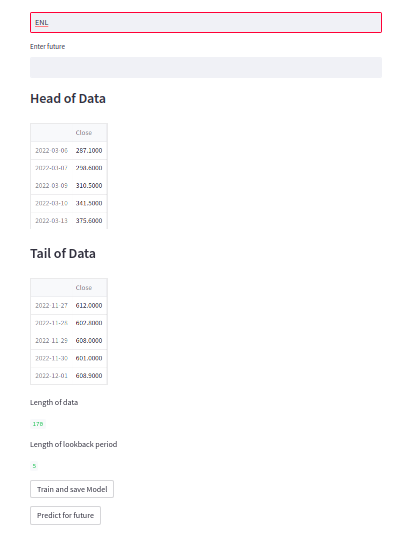
Entering the value of future
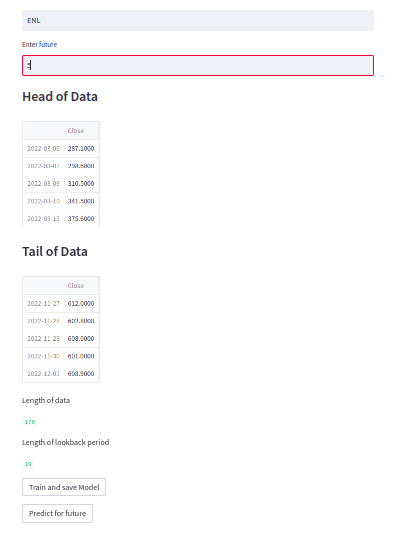
Training

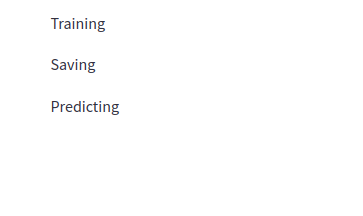
Comparison
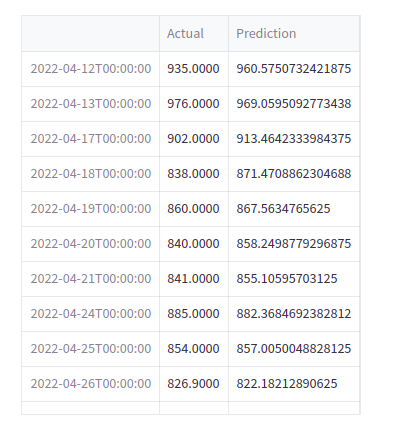
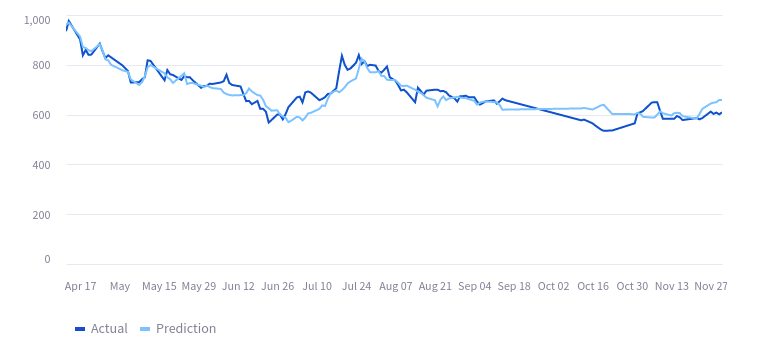

Final Prediction

Adding the files to git repository
git add .
git commit -m "Basic Files"
git push -u origin mainAdding requirements file
python3 -m pip freeze>requirements.txt
#pushing it to git using code in above section
Hosting app on streamlit cloud
Sign up with your github account
Signin
On right top you will see New App option
Click It
You will see following
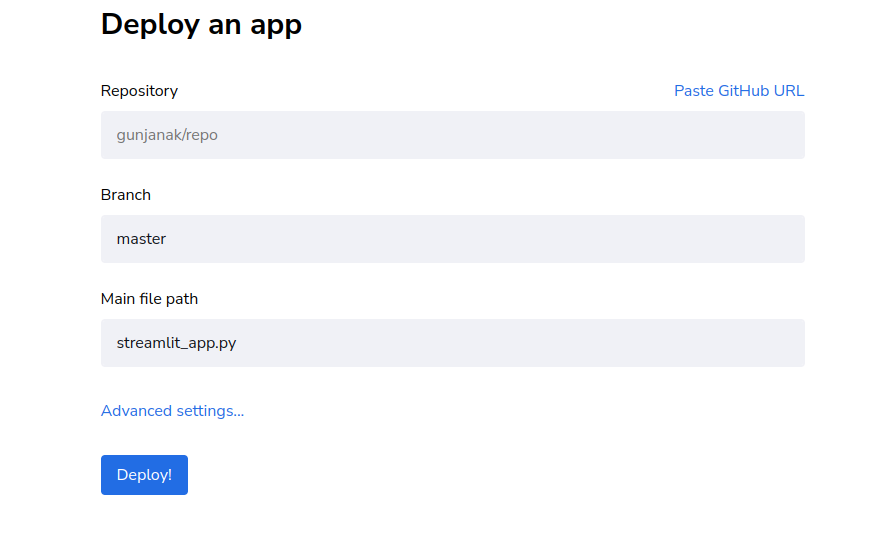
Paste your github repository.
Paste Your branch
The streamlit file
Paste Deploy
It will take some time.
Application On Streamlit
